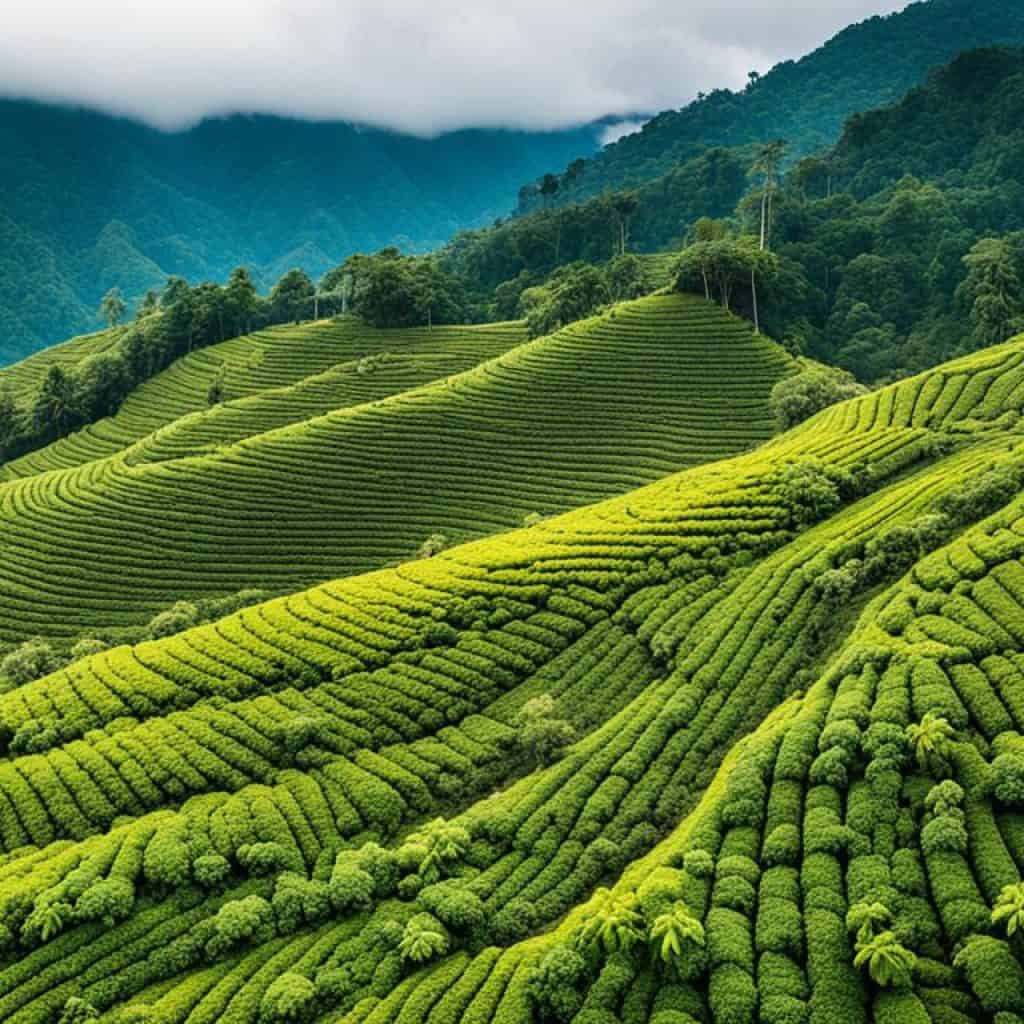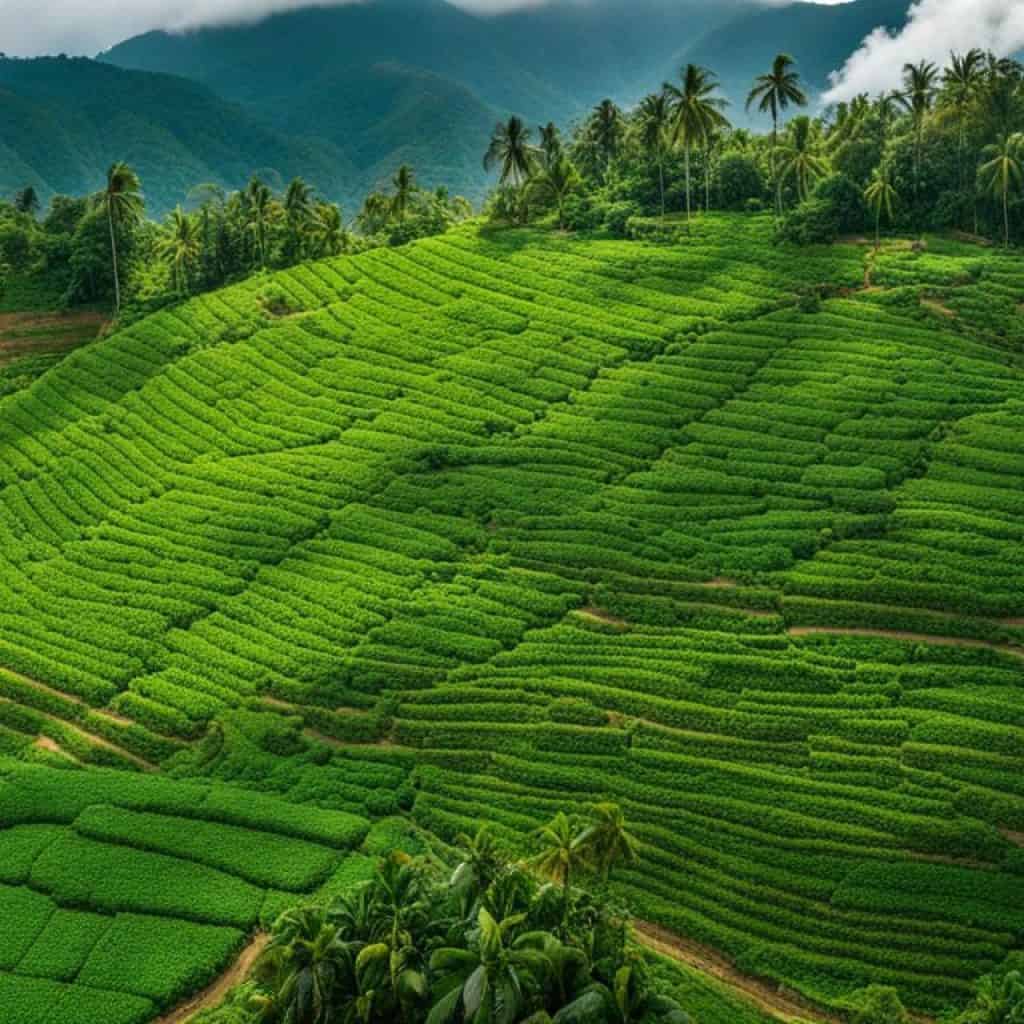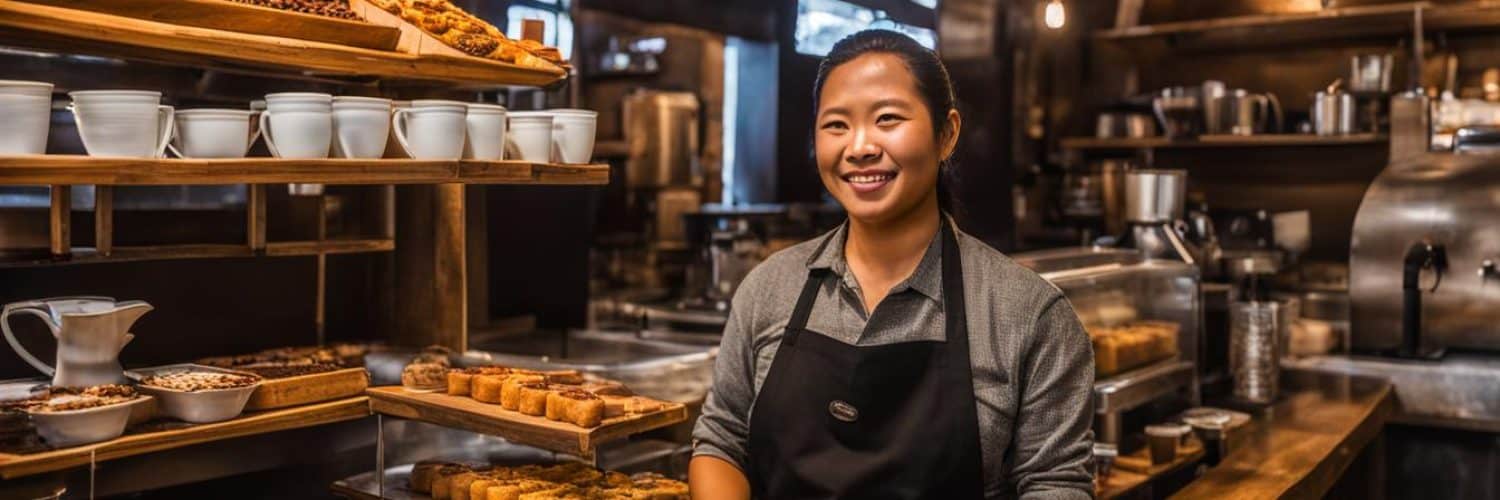Are you ready to embark on a coffee journey like no other? Discover the rich and vibrant world of Filipino coffee, where centuries-old traditions meet modern craftsmanship. From rare Liberica brews to specialty Arabica beans, the Philippines offers a treasure trove of unique and exquisite coffee flavors.
Join us as we explore the best coffee in the Philippines and uncover the top coffee shops that are redefining the specialty coffee scene in this caffeine-loving nation. Get ready to indulge your senses and experience the true essence of Filipino coffee culture!
Key Takeaways:
- Discover the diverse range of coffee varieties and flavors the Philippines has to offer.
- Explore the top coffee shops that are pushing the boundaries of specialty coffee in the country.
- Learn about the rich history and challenges faced by the Philippine coffee industry.
- Uncover the unique ways to brew and enjoy Filipino coffee.
- Understand the health benefits of coffee and why it has become an integral part of Filipino culture.
Liberica Coffee: Artisans Barako Gold
When it comes to unique and flavorful coffee experiences, Artisans Coffee has something extraordinary to offer. Introducing their dark roast Liberica coffee, Barako Gold.
This exquisite Liberica coffee delivers a perfectly balanced flavor profile that will delight your taste buds. With notes of nuttiness and a hint of spiciness, this brew offers a truly distinct and captivating taste. The pleasant touch of orange acidity in the finish adds a refreshing twist to every sip.
To fully appreciate the depth of flavors in Artisans Barako Gold, it’s recommended to brew this special coffee using a French press or as a unique espresso. These brewing methods bring out the intricate nuances of the Liberica beans, resulting in a truly remarkable coffee experience.
“Artisans Coffee has truly crafted a masterpiece with their Liberica coffee blend, Barako Gold. Its balanced flavor profile and intriguing notes make it a standout choice among coffee enthusiasts seeking something extraordinary.”
Ground Coffee: Batangs Best Premium Barako
Batangs Best Premium Barako is a medium-dark roast ground coffee that offers a flavorful and aromatic coffee experience. With its distinctive characteristics, this coffee is sure to satisfy your taste buds and awaken your senses.
The Batangs Best Premium Barako is known for its exceptional aroma and mellow flavor profile. It features gentle earthy notes with a subtle hint of cocoa, creating a harmonious balance that delights your palate.
Whether you prefer to enjoy your coffee in the morning or throughout the day, Batangs Best Premium Barako is a versatile choice that complements any occasion. Its rich and smooth taste makes it perfect for savoring on its own or pairing with your favorite desserts.
To bring out the best flavors of Batangs Best Premium Barako, you can choose to brew it using a drip machine or a pour-over dripper. These brewing methods allow the coffee to extract its full potential, resulting in a rich and satisfying cup of java.
Notable Features of Batangs Best Premium Barako:
- Medium-dark roast
- Powerful aroma
- Mellow flavor
- Earthiness with a cocoa finish
- Suitable for all-day enjoyment
- Brew with a drip machine or pour-over dripper
Experience the delight of Batangs Best Premium Barako and indulge in the robust flavors that this ground coffee has to offer. Treat yourself to a truly remarkable coffee experience that will leave you craving for more.
“The aroma of Batangs Best Premium Barako is simply irresistible. Its unique flavor profile is a testament to the quality and dedication put into producing this exceptional coffee.” – Coffee Enthusiast
Arabica Coffee: Kape Manong George Dapliyan’s Coffee
Kape Manong George Dapliyan’s Coffee offers a truly special coffee experience with their specialty Arabica Typica beans sourced from Sagada. These beans are meticulously grown by George Dapliyan, a coffee farmer who has consistently produced exceptional quality. In fact, his dedication to his craft was recognized when he secured 5th place at the prestigious Philippine Coffee Quality Competition.
The beans undergo a meticulous wet processing method to bring out the best flavors and characteristics. They are then carefully roasted in Canada, resulting in a brew that is smooth, sweet, and highly satisfying. With each sip, you’ll be treated to delightful notes of caramel, cassava cake, and cocoa, creating a sensory journey that will leave you craving for more.
To truly appreciate the subtleties of Kape Manong George Dapliyan’s Coffee, we recommend brewing it with a pour-over brewer or an Aeropress. These brewing methods allow the unique flavors and aromas to be fully expressed, giving you a truly indulgent coffee experience.
Why Choose Kape Manong George Dapliyan’s Coffee?
- High-quality Arabica beans from Sagada
- Produced by George Dapliyan, a renowned coffee farmer
- Award-winning coffee at the Philippine Coffee Quality Competition
- Meticulous wet processing and roasting for optimal flavors
- Smooth, sweet brew with notes of caramel, cassava cake, and cocoa
- Best enjoyed with a pour-over brewer or an Aeropress
Kape Manong George Dapliyan’s Coffee offers a truly exceptional coffee experience with their specialty Arabica Typica beans. From the careful cultivation by George Dapliyan to the meticulous wet processing and roasting, every step is taken to ensure the highest quality. The result is a brew that is smooth, sweet, and brimming with delightful flavors. Indulge in the rich and aromatic notes of caramel, cassava cake, and cocoa with each sip. Elevate your coffee experience with Kape Manong George Dapliyan’s Coffee.
The Diversity of Growing Regions
The Philippines is renowned for its diverse coffee-growing regions, each characterized by unique microclimates and flavor profiles. Let’s explore some of the major coffee-growing regions:
Batangas
Batangas is known as the birthplace of Philippine coffee, and it remains an important coffee-growing region to this day. This region is famous for its bold and distinctive Liberica coffee, which offers a rich, full-bodied taste with earthy and fruity notes. The fertile volcanic soil of Batangas contributes to the exceptional quality of the coffee grown here.
Cordillera Mountain Range
The Cordillera Mountain Range in northern Luzon is home to two well-known coffee-growing regions: Benguet and Sagada. These regions produce high-quality Arabica beans that thrive in the cool mountainous climate. Benguet Arabica is recognized for its bright acidity, floral aroma, and hints of citrus and chocolate. On the other hand, Sagada Arabica offers a smoother, more delicate profile with notes of caramel and nuts.
Mindanao
Mindanao, the second-largest island in the Philippines, boasts a diverse range of coffee varieties and growing regions. It is here that you will find the famous civet coffee, made from the beans excreted by the civet cat after consuming ripe coffee cherries. Two notable coffee-growing mountains in Mindanao are Mount Matutum and Mount Apo, which produce exceptional Arabica and Robusta beans. The volcanic soil and favorable climate give these coffees their unique and desirable flavors.
Now, let’s take a closer look at the coffee-growing regions in the Philippines with a table:
| Region | Main Coffee Varieties | Flavor Profiles |
|---|---|---|
| Batangas | Liberica | Rich, full-bodied, earthy, fruity |
| Benguet | Arabica | Bright acidity, floral, citrus, chocolate |
| Sagada | Arabica | Smooth, delicate, caramel, nuts |
| Mindanao | Arabica, Robusta | Varies (depending on specific growing regions) |

As you can see, the Philippines offers a vibrant tapestry of coffee-growing regions, each contributing to the country’s diverse and flavorful coffee scene. Whether you prefer the bold intensity of Liberica, the nuanced profiles of Arabica, or the strength of Robusta, there is a coffee for every palate to discover in these diverse growing regions.
History of Coffee in the Philippines
The history of coffee in the Philippines can be traced back to the 18th century when Spanish colonists introduced coffee plants to the country. During the 1800s, the Philippines emerged as the world’s fourth-largest exporter of coffee, contributing significantly to the global coffee market.
However, the Philippine coffee industry faced various challenges that led to a decline in production. Coffee rust and insect infestations severely impacted coffee plantations, resulting in a significant decrease in coffee output.
Today, the Philippines ranks 33rd in global coffee production, with an annual production of approximately 26,000 pounds. Despite the decline, the country continues to cultivate coffee and contribute to the international coffee industry.
Despite the challenges faced by the coffee industry in the Philippines, efforts are being made to revive and strengthen the production of this beloved beverage. Farmers and coffee enthusiasts are working hand in hand to improve cultivation techniques, develop disease-resistant coffee varieties, and explore sustainable farming practices.
The history of coffee in the Philippines serves as a testament to the resilience and dedication of the country’s coffee growers. With a rich heritage and a growing appreciation for specialty coffee, the future of the Philippine coffee industry looks promising.
“The decline in coffee production in the Philippines has sparked a renewed determination to protect and promote this valuable industry. It is an opportunity for us to rediscover our coffee heritage and support local coffee farmers in their journey towards sustainability.”
The Role of Climate
The Philippines’ diverse climate plays a crucial role in coffee production, providing optimal growing conditions for various coffee varieties. The country’s tropical climate, with its distinct wet and dry seasons, contributes to the unique flavors and characteristics of Philippine coffee beans.
However, climate change has presented significant challenges for coffee farmers in recent years. The increase in the frequency and severity of typhoons has resulted in substantial damage to coffee farms, affecting both the quantity and quality of coffee production. The destructive power of these weather events has disrupted the delicate balance necessary for successful coffee cultivation.
Furthermore, rising temperatures, shifting rainfall patterns, and changes in humidity levels have a direct impact on the growth and health of coffee plants. Extreme weather conditions, such as prolonged droughts or heavy rainfall, can lead to poor harvests, increased pest infestations, and the spread of diseases among coffee crops.
The image below illustrates the impact of climate change on coffee farms:

As the image shows, climate change has the potential to disrupt coffee production, threatening the livelihoods of coffee farmers and impacting the availability and quality of coffee in the market.
Coffee Farming Challenges Caused by Climate Change:
- Increase in the frequency and severity of typhoons
- Shifts in rainfall patterns and prolonged droughts
- Rising temperatures and changes in humidity levels
- Pest infestations and the spread of diseases
These challenges necessitate the adoption of climate-resilient farming practices and the development of strategies to mitigate the impact of climate change on coffee farms. Investments in research, technology, and farmer education are crucial for building resilience and ensuring the sustainability of the coffee industry in the face of a changing climate.
Strategies to Mitigate the Impact:
- Implementing agroforestry practices to promote shade and biodiversity
- Introducing drought-tolerant coffee varieties
- Improving water management and irrigation systems
- Strengthening early warning systems and disaster preparedness
- Supporting farmers in adopting sustainable and climate-smart agricultural practices
In conclusion, the role of climate in coffee production cannot be overstated. While the Philippines benefits from its diverse climate, the challenges posed by climate change require collective action and innovation to ensure the longevity and resilience of coffee farms. By addressing these challenges head-on and implementing sustainable practices, the coffee industry can adapt and thrive in the face of a changing climate.
| Climate Change Challenges | Adaptation Strategies |
|---|---|
| Increase in the frequency and severity of typhoons | Strengthening early warning systems and disaster preparedness |
| Shifts in rainfall patterns and prolonged droughts | Improving water management and irrigation systems |
| Rising temperatures and changes in humidity levels | Implementing agroforestry practices to promote shade and biodiversity |
| Pest infestations and the spread of diseases | Introducing drought-tolerant coffee varieties |
| Supporting farmers in adopting sustainable and climate-smart agricultural practices |
The Struggle for Specialty Coffee
The specialty coffee industry in the Philippines faces several challenges in fully establishing itself within the local market. Imported coffees from countries like Vietnam and Indonesia often dominate the market, offering cheaper prices and better quality, making it difficult for local coffee producers to compete.
One of the main obstacles is the lack of infrastructure and education for Filipino coffee farmers. Limited access to resources, including modern processing facilities and advanced farming techniques, hinders efforts to improve the quality of locally produced specialty coffee. As a result, local farmers often struggle to meet the high standards set by international markets.
However, despite these challenges, there are promising initiatives led by the government and non-governmental organizations (NGOs) to support the growth of the local coffee industry. These initiatives focus on providing better infrastructure, training programs, and financial assistance for coffee farmers. By empowering local producers with the necessary resources and knowledge, the aim is to enhance the quality and competitiveness of specialty coffee in the Philippines.
Furthermore, Filipino coffee farmers are increasingly embracing sustainable and ethical practices, such as organic farming and fair trade certifications. These initiatives not only promote environmental stewardship but also help local producers differentiate their products in the market and capture the attention of conscious consumers.
In summary, while the specialty coffee industry in the Philippines faces challenges in competing with imported coffees and improving overall quality, there are ongoing efforts to support and uplift the local coffee industry. With the right infrastructure, education, and sustainable practices, there is great potential for the Philippines to establish itself as a prominent player in the specialty coffee sector.
Coffee Culture in the Philippines
The Philippines has seen a significant rise in coffee consumption, reflecting the growing coffee culture in the country. By 2025, Filipinos are projected to consume an average of 8.33 pounds of coffee per person, indicating a strong demand for the beloved beverage.
In recent years, the emergence of third-wave coffee shops has played a crucial role in shaping the coffee culture in the Philippines. These specialty coffee establishments have gained popularity among a younger generation of coffee enthusiasts who seek a higher quality coffee experience. The trend towards specialty coffee reflects a shift in consumer preferences and a desire for unique, artisanal brews.
The Philippine National Barista Championship has also contributed to the growth of coffee culture by showcasing the talent and potential of local baristas. This event not only highlights the skills of these coffee professionals but also generates more interest in specialty coffee among consumers.
Unique Ways to Brew Filipino Coffee
Filipino coffee is renowned for its rich flavors and unique characteristics. While the traditional way of brewing Filipino coffee involves the popular Barako coffee, there are other creative methods that can elevate your coffee experience. One delightful way to enjoy the flavors of Filipino coffee is by preparing coffee jelly. Coffee jelly is a chilled treat made by combining brewed coffee with gelatin, sugar, and condensed milk. This refreshing dessert combines the boldness of coffee with a smooth and creamy texture.
Brewing Methods for Filipino Coffee
Aside from coffee jelly, there are different brewing methods that you can explore to unlock the distinct flavors of Filipino coffee:
- French Press: This brewing method allows you to extract the full-bodied flavors of Filipino coffee. The immersion process enhances the richness and aroma, resulting in a robust and flavorful cup.
- Pour Over: For a more refined and delicate flavor profile, the pour-over method is an excellent choice. This method allows for precise control over the extraction process, highlighting the nuanced flavors and acidity of Filipino coffee.
- Aeropress: The Aeropress is a versatile brewing method that produces a clean and smooth cup of coffee. It allows for quick extraction while retaining the distinct characteristics of Filipino coffee.
Experimenting with different brewing methods can enhance your coffee experience and help you discover new flavors and aromas.
Benefits of Coffee Jelly
Coffee jelly is not only a delicious way to enjoy Filipino coffee, but it also offers several benefits:
“Coffee jelly is a refreshing and indulgent treat that combines the bold flavors of coffee with a satisfying jelly texture. It’s perfect for those hot summer days or as a delightful dessert after a meal. Plus, it provides a creative way to savor the flavors of Filipino coffee beyond the traditional brewing methods.”
In addition to its flavorful taste, coffee jelly is also a good source of energy and a great way to satisfy your sweet tooth. It contains caffeine, which can help boost alertness and improve focus. Additionally, the gelatin in coffee jelly provides collagen, which promotes healthy skin, hair, and joints.

Recipe: Filipino Coffee Jelly
If you’re interested in making your own coffee jelly, here’s a simple recipe to get you started:
| Ingredients | Instructions |
|---|---|
| Gelatin Sheets | Soak the gelatin sheets in cold water until softened. Drain and set aside. |
| Brewed Filipino Coffee | Prepare a strong cup of Filipino coffee using your preferred brewing method. |
| Sugar | Add sugar to the brewed coffee, adjusting the amount to your desired sweetness. |
| Condensed Milk | Add condensed milk to the coffee mixture, stirring until well combined. |
| Gelatin Mixture | In a saucepan, gently heat the gelatin sheets until melted. Remove from heat and let it cool slightly. |
| Coffee and Gelatin Mixture | Slowly pour the gelatin mixture into the coffee mixture, stirring continuously. |
| Chilled | Pour the coffee jelly mixture into individual molds or a large glass dish. Refrigerate until set. |
| Serve | Serve the coffee jelly chilled and enjoy! |
Feel free to customize the recipe by adding toppings like whipped cream or chocolate shavings. Let your creativity shine and savor the unique flavors of Filipino coffee through this delightful treat.
Best Coffee Brands and Shops in the Philippines
In addition to the mentioned coffee brands, there are several other notable coffee brands and shops in the Philippines that offer exceptional brews. Here are some of the top picks:
- Caravan Black Coffee: Known for their specialty single-origin coffee beans sourced from different regions in the Philippines, Caravan Black Coffee offers a wide variety of flavors and profiles.
- Commune: A local favorite, Commune is a specialty coffee shop that focuses on serving carefully crafted brews using locally sourced beans. They also promote sustainable practices in the industry.
- Key Coffee Kissaten: With a cozy and nostalgic ambiance, Key Coffee Kissaten brings a taste of Japan to the Philippines. They offer a selection of premium Japanese coffee alongside local favorites.
- Perk Up Coffee: Perk Up Coffee is a homegrown coffee brand that aims to showcase the rich flavors of Philippine coffee. They offer a range of blends and single-origin beans from different regions.
If you’re looking for unique and ethically sourced coffee, here are a few more notable coffee brands and shops worth exploring:
ECHOstore – Edsa Beverage Design Group – Malongo – The Dream Coffee – Cafe Seventy Six – Because Coffee – Single Origin – Yardstick Coffee – El Union Coffee
Each of these coffee brands and shops offers a distinct coffee experience, showcasing the best of the Philippines’ coffee culture and flavors.
Health Benefits of Coffee
Coffee is more than just a flavorful beverage; it has numerous health benefits that make it an excellent choice for your daily routine. Packed with antioxidants and essential nutrients, coffee offers a range of advantages that can improve your overall well-being.
Reduced Risk of Depression
Studies have shown that coffee consumption is associated with a lower risk of depression. Coffee contains compounds that stimulate the production of neurotransmitters like dopamine and serotonin, which are known to regulate mood and promote feelings of happiness and well-being.
Heart Disease Prevention
Coffee has been linked to a reduced risk of heart disease. Regular coffee intake may help lower the risk of stroke, heart failure, and other cardiovascular conditions. The antioxidants found in coffee can help protect against the oxidative damage that can lead to heart problems.
Protection against Type 2 Diabetes
Drinking coffee has been associated with a lower risk of developing type 2 diabetes. The compounds in coffee help regulate blood sugar levels and improve insulin sensitivity. By incorporating coffee into your diet, you may reduce the risk of this prevalent metabolic disorder.
Benefits for Brain Health
Coffee consumption has been linked to a decreased risk of neurodegenerative diseases such as Parkinson’s and Alzheimer’s. The antioxidants and bioactive compounds in coffee offer protection against brain cell damage and may delay the onset of these age-related conditions.
Liver Disease Prevention
Regular coffee consumption has also been shown to reduce the risk of liver disease, including liver cancer and cirrhosis. The natural compounds in coffee help protect the liver from inflammation and promote healthy liver function.
Enhanced Physical Performance
Coffee is known to improve physical performance and endurance. The caffeine in coffee stimulates the nervous system, increasing adrenaline levels and enhancing muscle function. This can improve your stamina during workouts or physical activities.
Boosted Metabolism
Coffee has been found to increase metabolism and promote fat burning. The caffeine content in coffee can boost the metabolic rate, making it easier for the body to burn calories and potentially aiding in weight management.
Risks and Moderation
While coffee offers numerous health benefits, it’s important to consume it in moderation and be mindful of individual sensitivities or health conditions. Excessive coffee consumption can lead to side effects such as increased heart rate, restlessness, and disrupted sleep patterns. It’s also essential to note that some individuals may be more sensitive to the effects of caffeine and should limit their intake accordingly. Consulting with a healthcare professional can provide personalized guidance on coffee consumption based on individual circumstances.
With its array of health benefits and delightful flavors, coffee can be a valuable addition to a balanced and healthy lifestyle. Incorporate coffee into your daily routine and enjoy the wide-ranging advantages it offers, from mental well-being and disease prevention to improved physical performance. Remember to savor each cup mindfully and engage in responsible coffee consumption to reap the full health benefits of this beloved beverage.
Conclusion
The Philippines offers a coffee experience like no other, with its diverse range of coffee varieties and flavors. Despite facing challenges in the industry, such as competition from imported coffees and a lack of infrastructure, there is a growing interest in specialty coffee and a concerted effort to improve the quality of local production. This bodes well for the future of the Philippine coffee industry, which has the potential to establish itself as a major player on the global coffee stage.
Whether you’re a coffee connoisseur or someone who appreciates a good brew, exploring the best coffee in the Philippines is a must. From the rich and bold flavors of Liberica coffee to the mellow and aromatic notes of Arabica, there is something to satisfy every palate. Indulge yourself in the vibrant coffee culture of the Philippines and experience the passion and dedication that goes into each cup.
So, don’t miss out on the opportunity to embark on a coffee adventure in the Philippines. Treat yourself to the finest brews, support the local coffee industry, and immerse yourself in the unique flavors and aromas that Filipino coffee has to offer. The journey awaits, and with each sip, you’ll discover the true essence of Philippine coffee.


















Add comment